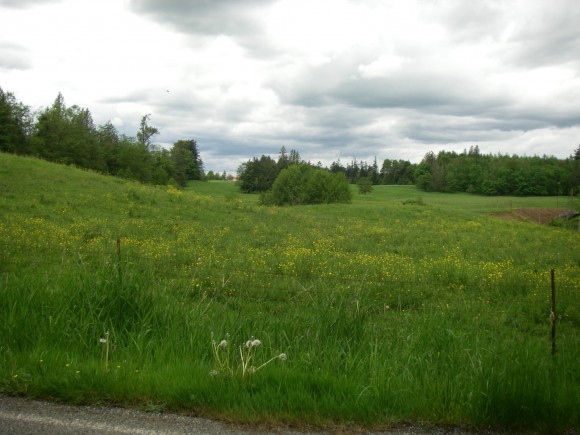
Protecting Dirt, Among Other Things
by: Whatcom Land Trust Posted on: November 01, 2010
By Connie Clement, Outreach Coordinator of Whatcom Land Trust
27 years ago, Whatcom County farmers were concerned about agricultural land being converted to other uses. They gathered a group of farmers, lawyers, environmentalists, bankers, accountants, business people, church officials, civic leaders, university authorities, media and government officials in the basement of Dutch Mothers, a local Lynden restaurant, to discuss what could be done. From those meetings came the Whatcom Land Trust (WLT), founded in 1984.
The organization’s initial focus in those early days was the preservation of farm land. Herman and Diane Miller were the first to approach the fledgling land trust to seek assistance in protecting their 160-acre farm with a legal document called a conservation easement. The conservation easement keeps the land in agriculture, and prohibits it from being subdivided and sold for uses such as houses or shopping centers. The easement allowed the Millers to own and work their farm, to sell it or pass it to their heirs, but the document laid out specific restrictions of what could be done with that property in the future. No matter who owned the land, those restrictions would be part of the title.
With time, opportunities to protect other types of land presented themselves to the Land Trust. Political focus on the preservation of salmon habitat, forests, open space and salt water shorelines opened up opportunities for grants to preserve those kinds of lands. WLT saw the wisdom in those efforts and broadened its work to include such projects.
In 2004, the Whatcom County government began the Purchase of Development Rights program. This program uses funds from the Washington State Recreation and Conservation Office’s Farmland Preservation Fund, along with the USDA’s federal Farm and Ranch Lands Protection Program and matches those grants with dollars from Whatcom County’s Conservation Futures fund. These funds are used to acquire farmland development rights. Once Whatcom County purchases development rights from a farmer, a conservation easement is placed on the land to keep the land in agriculture forever. Whatcom Land Trust, an independent non-profit, not connected to government, co-holds the easement and has a responsibility, in perpetuity, to make certain the land is used according to its easement.
Since the PDR program began, 12 easements have been placed on 671 acres. If all transactions currently pending result in easements, the program will protect 896 acres on 15 farms. Unfortunately, with government funding shrinking, this program will shrink as well in coming years.
This partnership with Whatcom County government is an example of the positive relationship WLT has with various government entities. WLT often leverages grants for projects with private funding, and in turn, monitors and stewards the protected properties interminably. This is no small task. Regularly monitoring the properties and enforcing the restrictions of the conservation easements or grant is what keeps the land in its intended use and protects it against future legal challenges.
While the political climate changes through time, Whatcom Land Trust has a duty and commitment to protect the lands held under its conservation easements, as well as lands it owns. Currently, this is over 10,000 acres of wildlife habitat, scenic, agricultural and open space lands in Whatcom County. With a small staff and a cadre of active volunteers, the Land Trust continues to look for ways to protect agricultural land and wildlife habitat. As in its beginning, the passion of the people is what sustains the organization and makes it successful.
To find out more about Whatcom Land Trust or to volunteer or make a donation, visit our website at www.whatcomlandtrust.org.
2 Responses to “Protecting Dirt, Among Other Things”
Articles On Dirt
Dirt: Dirt
- Mar 6 Re-Imagining Local Public Space, From Parks to Post Offices
- Nov 7 Google Cache Snapshot-Oregonlandco.com, 9/15/13
- Nov 7 Testimony
- Nov 7 Sustainable Forestry Initiative Confirms
- Sep 8 Why Label Genetically Modified Food?
- Sep 8 Why Not Label Genetically Modified Food?
- Sep 8 When Industrial Slaughterhouses Are Proposed
- Aug 8 ¡HUELGA! Mixteco and Triqui Farmworkers commence second Work Stoppage at Sakuma Brothers Farms, Inc.
- Aug 8 Bolivia: Building Resilience To Climate Change Through Indigenous Knowledge – The Case Of Bolivia
- Jun 8 A Conversation about School Lunches, a Student and a Farmer
- Oct 21 On Kids and Food
- Sep 30 Empowered Latino Farmers (Spanish & English Translations Included)
- Sep 16 Whatcom Farm-to-School: Tackling Food System Challenges One Lunch at a Time
- Aug 10 Sludge, Whose Jurisdiction? (Part 2)
- Jul 30 Sludge, Whose Jurisdiction? (Part 1)
- Jul 9 Rethinking the Peasant
- Jun 25 The Beginning of Regional Food Governance?
- May 29 Urban and Suburban Agriculture Empowers Environmental Stewards
- May 13 Northwest Soil Science: Nitrogen Mineralization
- Feb 3 WA Conservation Districts: An Introduction
- Jan 20 Planning For A Future: Protecting The Ground
- Jan 12 Recirculating Farms
- Dec 30 Columbia Basin Water Development
- Jan 25 No Fisherman Deserves a Toxic River
- Dec 15 Conserving Working Lands, Native Species, and Fertile Soil
- Nov 1 Protecting Dirt, Among Other Things
- Oct 25 Coming Soon


by: Lauraon: Monday 8th of November 2010
by: Pollyon: Thursday 4th of October 2012